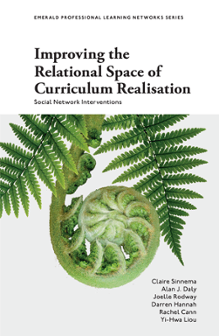
Index
Improving the Relational Space of Curriculum Realisation: Social Network Interventions
ISBN: 978-1-80382-516-8, eISBN: 978-1-80382-513-7
Publication date: 20 July 2023
Citation
Sinnema, C., Daly, A.J., Rodway, J., Hannah, D., Cann, R. and Liou, Y.-H. (2023), "Index", Improving the Relational Space of Curriculum Realisation: Social Network Interventions (Emerald Professional Learning Networks Series), Emerald Publishing Limited, Leeds, pp. 197-204. https://doi.org/10.1108/978-1-80382-513-720231021
Publisher
:Emerald Publishing Limited
Copyright © 2023 Claire Sinnema, Alan J. Daly, Darren Hannah, Joelle Rodway, Rachel Cann, and Yi-Hwa Liou
INDEX
- Prelims
- Introduction
- Part 1. Setting the Scene
- Part 1-Introduction
- 1. A Social Network Lens on Curriculum Realisation
- 2. Social Network Interventions
- 3. A Theory of Action Approach to Examining Interventions
- 4. The Policy Landscape and the Project Context
- 5. Insights into the Relational Space: Our Approach to Data Collection and Analysis
- Part 2. Better Together Intervention Theory of Action
- Part 2-Introduction
- 6. Hui 1 – Providing Grounded Stimulus
- 7. Hui 2 – Using Guided Discovery
- 8. Hui 3 – A Problem-Solving Approach to Action Planning
- 9. Hui 4 – Shoes of Others
- Part 3. Intervention Impact and Looking Forward
- Part 3-Introduction
- 10. Shifts in the Relational Space
- 11. Looking Back to Move Forward
- References
- Index